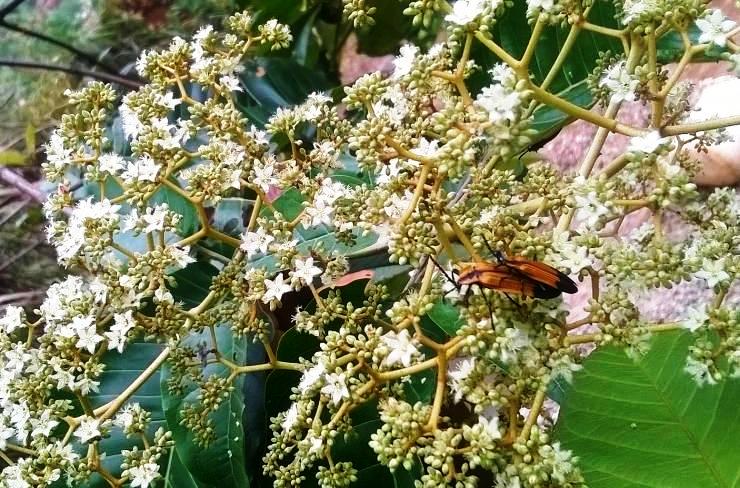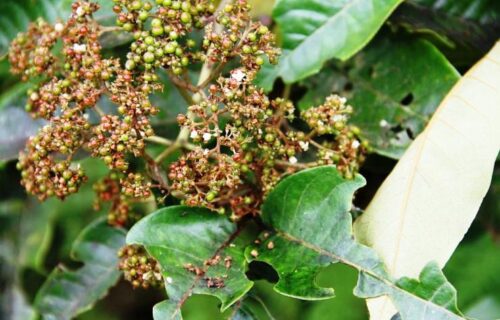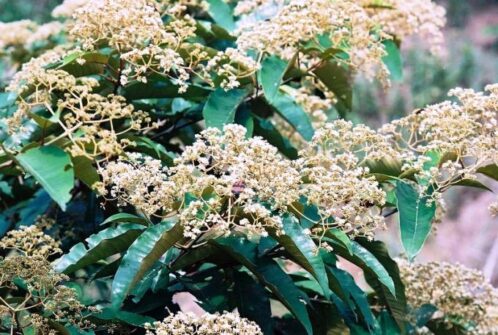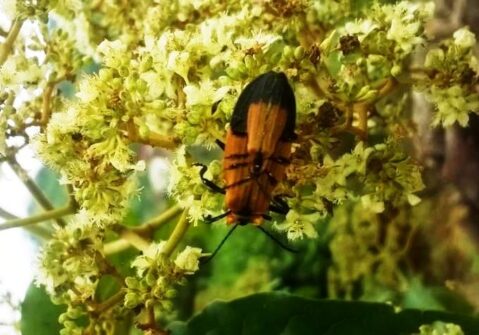Herbs & Plants. Harungana madagascariensis. An edible medicinal plant.

The plant has been used over many years in African herbal medicine for the treatment of a wide range of human illnesses.
It is a small to medium-sized bushy tree, about 4-7m in height. Bark brown, rough and scaly, with orange sap when damaged. Leaves opposite, elliptic, up to 20 cm long, dark shiny green above, densely covered in rusty hairs below; margin entire. Young leaves at stem apex flattened together. Flowers in dense, branched, terminal heads, creamy-white, hairy inside, with glandular dots near the apex, sweetly scented. Fruit in clusters, 2-4 mm in diameter, greenish-orange to red when ripe.
The plant is native to Central Africa, the Democratic Republic of Congo, Sudan, Ethiopia, Lesotho, and South Africa.
Harungana madagascariensis plant (Family Hypericaceae) has been used over many years in African herbal medicine for the treatment of a wide range of human illnesses especially for treating skin complaints. It is an edible medicinal plant.

CC BY-SA 4.0/Denis Barthel
The bark is employed in the treatment of river blindness, ulcer, asthma, hepatitis, dysmenorrhea, and toothache. The bark and roots, either alone or in combination with other plants, are administered for ailments such as gonorrhea, leprosy, hemorrhoids and to facilitate childbirth. A bark-decoction, or of the root, is widely deemed helpful as a remedy for a range of troubles in which blood is manifest including haematuria and piles; as an emmenagogue and oxytocic for a range of gynaecological conditions including expelling the placenta, miscarriage, dysmenorrhoea, irregular or painful menstruation; cough with bloody sputum. The stem bark decoction is also used for the treatment of malaria. The bark, sap and gum are particularly valued and are held to be aphrodisiac, astringent, emetic, expectorant, haemostatic, styptic and vermifuge. The bark decoction is used in the treatment of dysentery and is also given to babies suffering from constipation. The bark or the gum is administered as a purgative. In some communities, the bark and the leaves are used for stomachache. Ash obtained from burning Harungana madagascariensis bark is applied to treat scabies.
Both the bark and the gum are used for treating chest and breathing difficulties. In fact, the bark decoction is administered for treatment of bronchial infections, coughs, and asthma.

CC BY-NC 2.0/Scamperdale
The root infusion/decoction is used in a treatment to hasten breast development in young women. The twigs, leaves and leaf-buds find similar medicinal uses to the bark and sap and are often used to treat a similar range of conditions. Decoction prepared from the leaves is used to cure dysentery, diarrhea, anemia, typhoid, and some heart ailments such as tachycardia. The leaves are used in the treatment of chest problems, dysentery while the latex of the plant is employed for treating skin diseases and as a dressing material for wounds.
Harungana madagascariensis leaves decoction is used for the treatment of chest pains and urogenital infections. Postpartum bleeding is arrested by the sap of the leaves and stem bark. Additionally, the sap is also used to treat indigestion and poor pancreatic function. The leaves and roots are also considered febrifugal and anti-malarial. The leafy shoots are chewed as a masticatory with kola nut for treating urethral discharge.

CC BY-SA 4.0/Hermy71
The gummy sap is used as an enema to treat enteritis leprosy, ringworm, and skin diseases. The sap expressed from the inner bark is taken slightly warmed as a purgative and as a remedy for tapeworm. The resinous sap is applied externally to treat all manner of cutaneous complaints including leprosy, sores, itch, scabies, ringworm, craw-craw, and jaundice. The gum is applied to cuts, including fresh circumcision wounds, and ulcers. The dried gum is also used as a wound dressing. The gum evokes the usage of the bark, roots, or the gum itself for treatment. The fruit is a laxative and as well used as an emetic. The resin from the flower is used for treating colic, puerperal infection, and roundworm as a rubefacient.
The leaves of Harungana madagascariensis is a rich fodder for goats and sheep. The stem bark is used as a local dye for clothing and traditional costumes and its dried and crushed seeds used as soup spice. The bark and roots are chewed as a substitute for toothpaste and are also used as lipstick. The fruits have a sweet flavor and are eaten as a snack, especially by children. (Photo: CC BY-SA 4.0/Hermy71)
Richard Komakech



